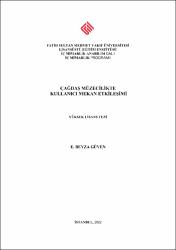Çağdaş Müzecilikte Kullanıcı Mekan Etkileşimi
Künye
GÜVEN, E. Beyza, Çağdaş Müzecilikte Kullanıcı Mekan Etkileşimi, Fatih Sultan Mehmet Vakıf Üniversitesi Lisansüstü Eğitim Enstitüsü İç Mimarlık Anabilim Dalı İç Mimarlık Programı,Yayımlanmamış Yüksek Lisans Tezi, İstanbul 2022.Özet
Uygarlık tarihinin başlamasıyla birlikte, insanlığın doğa ile kurduğu iletişim ve
bu iletişim neticesinde öğrendiği koyduğu pratikler kültür kavramını ortaya çıkarmış,
insanlığın doğaya karşın ürettiği her değer de kültür olarak tanımlanmıştır. Kültür, ait
olduğu yeryüzü parçası ve üretildiği topluluk hakkında referanslar barındırır, birikir,
zenginleşir, kuşaktan kuşağa aktarılır. Ayrıca doğaya karşı mücadeleyi öğrenen
insanlık, ürettiği maddi kültür alanlarının yanı sıra, bilim ve sanat alanında çalışmalar
da yürütür. Bu bağlamda, birikerek zenginleşen kültür, sanat ve bilim somut veya
soyut yöntemlerle kuşaklar arası iletişim sağlanması amacıyla koruma altına alınarak
dinamikleşir. Bu dinamiklerin, bir araya gelmesi, sergilenmesi ve geçmiş öğretilerin
kuşaklara aktarılması müzecilik kavramını doğurmuştur. Süreç içerisinde de müzecilik
kendi mekanını arayarak bu kavramın mekansal dönüşümü ortaya çıkmıştır.
Bu çalışmada, kamusal bir mekan ve aynı zamanda toplumsal bir bellek
mekanları müzeler, 21. yy. insanının mekansal beklentileri ve çağına uygun sergileme
mekanlarının insan-mekân etkileşimi farklı başlıklar altında nitelikli bir şekilde
incelenmiştir. Müzecilik kavramı ve müzelerin mekansal gelişimi başlangıçtan
günümüze kronolojik bir periyotta incelenerek müze mekanlarının değişimi, birikimi
ve dönüşümünde ki kırılma noktaları belgelenerek, bu kırılmalardaki zaman-mekan,
mekan-insan etkileşimleri incelenmiştir. Bu bağlamda yurt dışından ve ülkemizden
seçilen müzelerdeki sergi, eser, tematik sergileme yöntemleri, ek işlevler ile
sergilemenin odağının değişmesi ve çeşitlenmesi iç mekân-insan etkileşimi
çerçevesinde irdelenmeye çalışılmıştır.
Çalışmanın ilk bölümünde “müze” kavramının tanımı açıklanarak ve bu
kavramın ortaya çıkışı ve tarihsel gelişimine yer verilerek Türk Müzecilik’inin
gelişimi de özel başlık altında açıklanmıştır. Çalışmanın asıl amacı olan insan-mekan
etkileşimi başlığı ikinci bölümde detaylı bir şekilde irdelenerek, incelemeyi daha
anlaşılır hale getiren temel bilgiler sunulmuştur. Müze mekanlarının hangi başlıklar
özelinde inceleneceği de bu bölümde belirtilmiştir. Üçüncü bölümde ise ülkemizden
ve yurt dışından seçilmiş olan müzeler, plan üzerinde incelenmenin yanı sıra iç mekan
incelemeleri de yapılarak, gözlemler aktarılmıştır. Bulgular-öneriler kısmında ise
“çağdaş müzecilik” anlamında mekanlar ve ziyaretçinin mekan ile etkileşimi üzerinde
durulmuştur. With the beginning of the history of civilization,communication of humanity
with nature and the practices put forward as a result of this communication revealed
the concept of culture and every value that humanity produced against nature was
defined as culture. Culture piles up, enriches and is handed down from generation to
generation. Besides, it contains references about the part of the earth it belongs to and
the community from which it emerged. Accordingly, humanity, which learns the
struggle against nature, carries out studies in the fields of science and art, as well as
the material culture fields it produces. In this respect, culture, science and art, which
are enriched by accumulation, become dynamic by taking them under protection in
order to ensure intergenerational communication with concrete or abstract methods.
By comig together, displaying, transferring of the past teachings to the generations of
these dynamics have given birth to the concept of museology. In this process,
museology sought its own space and the spatial transformation of this concept
emerged.
In this study, museums, which are a public space and also a social memory
spaces, the spatial expectations of the people of the 21st century and the human-space
interaction of the contemporary exhibition spaces have been examined under different
topics in a qualified way. The concept of museology and the spatial development of
museums have been studied in a chronological period from the beginning to the present
and also the breaking points in the change, accumulation and transformation of
museum spaces and the time-space, space-human interactions in these breaks have
been documented. In this regard, it has been tried to examine the exhibition, work of
art, thematic exhibition methods and additional functions with changing and
diversifying of the focus of the exhibition in the museums selected from the abroad
and our country within the framework of interior space-human interaction.
In the first part of the study, the definition of the concept of "museum" has been
explained and the emergence and historical development of this concept has been
given, and the development of Turkish Museology has also been explained under a
distinctive title. The subject of human-space interaction, which is the main purpose of
the study, has been examined in detail in the second part, and basic information that
makes the analysis more understandable has been presented. It has also been stated in
this section under which headings the museum spaces will be examined. In the third
part, the museums selected from the abroad and our country have been examined on the plan, as well as interior space examinations and observations have been conveyed.
In the findings-suggestions part, spaces in the sense of "contemporary museology" and
the interaction of the visitor with the space have been emphasized.



















